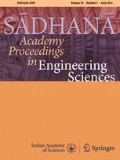Abstract
The current study investigates the effect of pulsation frequency on the near field characteristics of a submerged water jet using the technique of dye visualization. Flow visualization was performed in water over the range: Reynolds number 540–1540, Strouhal number 0.16–1.75, and at constant amplitude of pulsation of 18%. The results show that the mixing and entrainment process at lower Reynolds number occurs due to diffusion process owing to relatively stable shear layer for the case of a steady jet, whereas the external pulsation promotes an early instability in the shear layer where irregular structures promotes mixing between the jet and surrounding fluids. Images of streaklines show that initial mixing and entrainment processes in the potential core of the jet is due to the development of large vortical structures. While beyond the potential core, mixing and entrainment are governed by the small-scale structures. Further results show that the initiation and growth of vortices in the shear layer depends on the pulse frequency. For a given Reynolds number and amplitude, the number of vortical structures and their size changes with frequency. With an increase in the pulsation frequency, there is an increase in the spreading of the jet along with stretching of the vortical structures. An optimum pulsating frequency at which the effect of pulsation on the flow is maximum occurs at St = 0.44, independent of Reynolds number. These results should eventually lead to a better understanding of the physical phenomena responsible for enhanced mixing and entrainment processes in the presence of pulsating jets.



References
Dahm W J A and Dimotakis P E 1987 Measurements of entrainment and mixing in turbulent jets. AIAA Journal 25: 1216–1223
Ricou F P and Spanding D B 1961 Measurement of entrainment by axisymmetric turbulent jet. Journal of Fluid Mechanics 11: 21–23
Rankin G W, Sridhar K, Arulraja M and Kumar K R 1983 An experimental investigation of laminar axisymmetric submerged jets. Journal of Fluid Mechanics 133: 217–231
Yadav H, Agrawal A and Srivastava A 2016 Mixing and entrainment characteristics of a pulse jet. International Journal of Heat and Fluid Flow 61: 749–761
Agrawal A and Prasad A K 2003 Integral solution for the mean flow profiles of turbulent jets, plumes, and wakes. Journal of Fluids Engineering 125: 813–822
Mathew J and Basu A J 2002 Some characteristics of entrainment at a cylindrical turbulence boundary. Physics of Fluids 14: 2065–2072
Philip J and Marusic I 2012 Large-scale eddies and their role in entrainment in turbulent jets and wakes. Physics of Fluids 24: 055108
Crow S C and Champagne F H 1971 Orderly structure in jet turbulence. Journal of Fluid Mechanics 48: 547–591
Yule A J 1978 Large-scale structure in the mixing layer of a round jet. Journal of Fluid Mechanics 89: 413–432
Zaman K B M Q and Hussain A K M F 1984 Natural large-scale structures in the axisymmetric mixing layer. Journal of Fluid Mechanics 138: 325–351
Popiel C O and Trass O 1991 Visualization of a free and impinging round jet. Experimental Thermal and Fluid Science 4: 253–264
Han B and Goldstein R J 2003 Instantaneous energy separation in a free jet. Part I. Flow measurement and visualization. International Journal of Heat and Mass Transfer 46: 3975–3981
Cornaro C, Fleischer A S and Goldstein R J 1999 Flow visualization of a round jet impinging on cylindrical. Experimental Thermal and Fluid Science 20(2): 66–78
Johari H and Paduano R 1997 Dilution and mixing in an unsteady jet. Experiments in Fluids 23: 272–280
Otani Y, Norikazu N and Hitoshi E 1995 Removal of fine particles from smooth flat surfaces by consecutive pulse air jets. Aerosol Science and Technology 23: 665–673
Grosshans H, Szasz R-Z and Funchs L 2015 Enhanced liquid gas mixing due to pulsating injection. Computers and Fluid 107: 196–204
Farrington R B and Scott D C 1994 Infrared imaging of large-amplitude, low-frequency disturbances on a planar jet. AIAA Journal 32: 317–323
Yadav H, Srivastava A and Agrawal A 2016 Characterization of pulsating submerged jet—A particle image velocimetry study. Journal of Thermal Science and Engineering Applications 8: 011014
Xia Q and Zhong S 2013 Liquid mixing enhanced by pulse width modulation in a Y-shaped jet configuration. Fluid Dynamics Research 45: 025504
Author information
Authors and Affiliations
Corresponding author
Rights and permissions
About this article
Cite this article
YADAV, H., AGRAWAL, A. Effect of pulsation on the near flow field of a submerged water jet. Sādhanā 43, 44 (2018). https://doi.org/10.1007/s12046-018-0814-1
Received:
Revised:
Accepted:
Published:
DOI: https://doi.org/10.1007/s12046-018-0814-1

